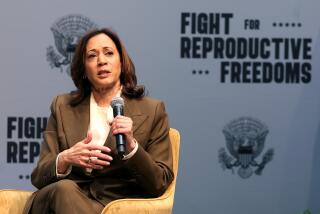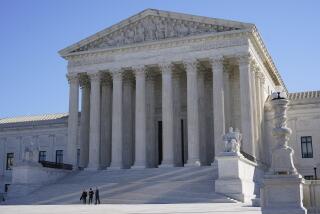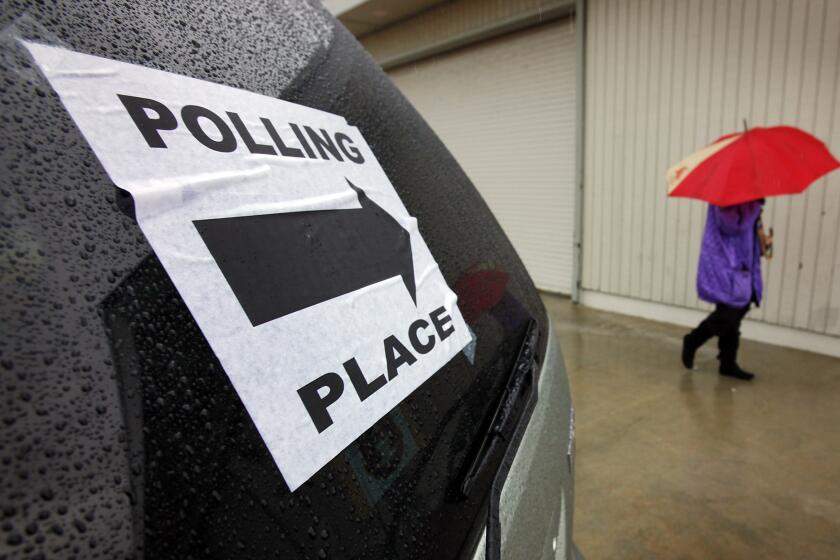House Votes to Outlaw ‘Partial Birth’ Abortions
WASHINGTON — The House on Wednesday approved a bill that would outlaw a controversial form of abortion, moving the measure a crucial step closer to becoming law and imposing the most significant limits on abortion in three decades.
The bill, which would ban a procedure that critics call “partial birth” abortion, passed 282 to 139. The Senate approved a nearly identical bill in March, 64 to 33.
For the record:
12:00 a.m. June 7, 2003 For The Record
Los Angeles Times Saturday June 07, 2003 Home Edition Main News Part A Page 2 National Desk 1 inches; 48 words Type of Material: Correction
Abortion bill -- An article in Section A on Thursday stated incorrectly that the U.S. Supreme Court has ruled on a Nebraska law that a procedure known as “partial birth” abortion is never medically necessary to protect a woman’s health. The Supreme Court has made no such ruling.
The two chambers are expected to quickly resolve the sole difference between their versions and send the bill to the White House.
President Bush has pledged to sign the legislation, which would make it the first federal statute criminalizing an established abortion procedure since the Supreme Court’s 1973 Roe vs. Wade decision. That ruling established a woman’s right to have an abortion before the time a fetus can live on its own.
In a statement released by the White House on Wednesday night, Bush praised House passage of what he called “this important legislation ... that will help build a culture of life in America.” He urged Congress to “send me the final bill as soon as possible so that I can sign it into law.”
However, abortion-rights advocates promised a quick legal challenge to the measure, including an effort to block it from taking effect while the court battle proceeds. “When the president signs it, we will immediately go to court to have it enjoined in order to safeguard the health of women,” said Vicki Saporta, spokeswoman for the National Abortion Federation, one of several groups preparing lawsuits against the legislation.
The measure’s constitutionality is in question because the Supreme Court in 2000 struck down a similar law that Nebraska had enacted. The justices ruled against the state law because, they said, it could ban many forms of abortion -- not just one procedure -- and did not provide an exception for cases when a woman’s health was at risk.
Proponents say the bill before Congress was drafted to withstand court scrutiny by making it clear that the ban would apply narrowly to the procedure that is generally used during the second trimester of pregnancy. Critics call it “partial birth” abortion because it involves partially removing an intact fetus from the womb before it is destroyed.
In the procedure, the fetus is pulled from the womb into the birth canal feet first. Before the head emerges, scissors are used to penetrate its skull.
Under the bill, doctors would be allowed to perform such a procedure only to save the life of a pregnant woman, but not for other health reasons.
The bill’s supporters said the broader health exception was not necessary because they believe it had already been established in the Nebraska case, in which the Supreme Court ruled that the procedure is never medically necessary to protect a woman’s health.
Critics dispute that, saying that removing a fetus intact is sometimes the safest procedure because it reduces bleeding, infection and other risks to the woman.
There is no consensus about how many abortions would be affected by the measure. But it likely would be just a fraction of the 1.3 million performed nationally in 2000, the latest year for which figures are available. The vast majority of abortions are performed during the first trimester of pregnancy.
Rep. Steve Chabot (R-Ohio), chief sponsor of the House bill, estimated that 2,200 to 5,000 “partial birth” abortions are performed each year.
Critics of the House bill say, however, that the effect of the measure could be broader because they believe the definition of the procedure is still vague enough that it could be seen as banning other, more common, procedures.
The bill would make it a crime to “deliberately and intentionally
During the House’s often highly charged debate, the bill’s supporters said the procedure it would ban was akin to infanticide. They argued that allowing it was a symptom of a morally corrupt culture.
“The victim is a nearly delivered baby,” said Rep. Henry J. Hyde (R-Ill.). “The law exists to protect the weak from the strong, and I can’t think of anything weaker than a nearly born infant.”
Rep. Ileana Ros-Lehtinen (R-Fla.) said, “Partial-birth abortion is a gruesome and inhumane procedure, and it is a grave attack against human dignity and justice.”
The measure’s opponents condemned it as an unconstitutional encroachment on women’s rights.
“This bill opens the door to outlawing all abortions, regardless of circumstances,” said Rep. Loretta Sanchez (D-Anaheim).
The critics also said it would improperly inject government regulation into what should be private medical decisions made by women and their doctors.
“The Congress of the United States has never -- ever -- outlawed a medical procedure,” said Rep. Louise McIntosh Slaughter (D-N.Y.). “What are we doing here? What in the name of God is next?”
Despite its uncertain effect and legal future, the signing of the bill would be a big victory for antiabortion groups that have been pushing Congress to act on the proposed ban since 1995.
The House and Senate approved similar legislation in 1996 and 1997, but those bills were vetoed by President Clinton.
The bill the Senate passed earlier this year included a nonbinding amendment expressing support for the Roe vs. Wade decision. That amendment was omitted from the House version of the bill.
House and Senate negotiators are expected to easily resolve that difference by dropping the amendment. That change is not expected to derail the measure when it comes back to the Senate for final approval.
The bill has drawn more widespread support than failed proposals to impose more sweeping restrictions on abortions, largely because of its focus on a procedure that even some backers of abortion rights view as extreme and hard to defend.
In the Senate, 48 Republicans and 16 Democrats voted for the bill.
In Wednesday’s House vote, 62 Democrats and 220 Republicans voted for the bill. Voting against it were 133 Democrats, five Republicans and one independent.
California’s House delegation split exactly along party lines, with 20 Republicans voting for the bill and 30 Democrats opposing it. Three Democrats did not vote -- Anna G. Eshoo of Atherton, Tom Lantos of San Mateo and Zoe Lofgren of San Jose.
Before approving the bill, the House rejected, 133 to 287, an alternative that would have banned all abortions of “viable” fetuses -- those that could survive outside the womb -- but allowed exceptions to preserve the life or health of the mother.
Without the health exception, the law would be an empty gesture because the Supreme Court would overturn it, supporters of the alternative predicted.
Opponents of the alternative argued that the exception for the woman’s health would include “mental health” -- which they said would be a loophole allowing almost any kind of abortion procedure to be used if a woman did not want to carry her pregnancy to term.
“Although represented by its sponsors as a ban on ‘late term’ abortions, in reality the substitute bans nothing,” said a statement from the National Right to Life Committee. “It empowers any abortionist to perform partial birth abortions at will.”
More to Read
Get the L.A. Times Politics newsletter
Deeply reported insights into legislation, politics and policy from Sacramento, Washington and beyond. In your inbox three times per week.
You may occasionally receive promotional content from the Los Angeles Times.











